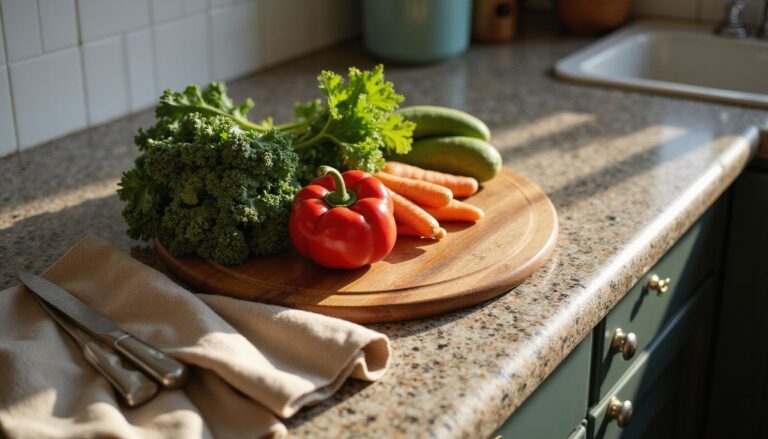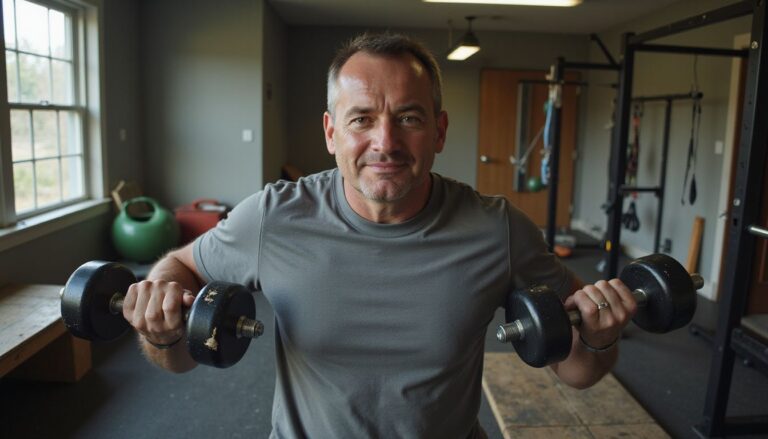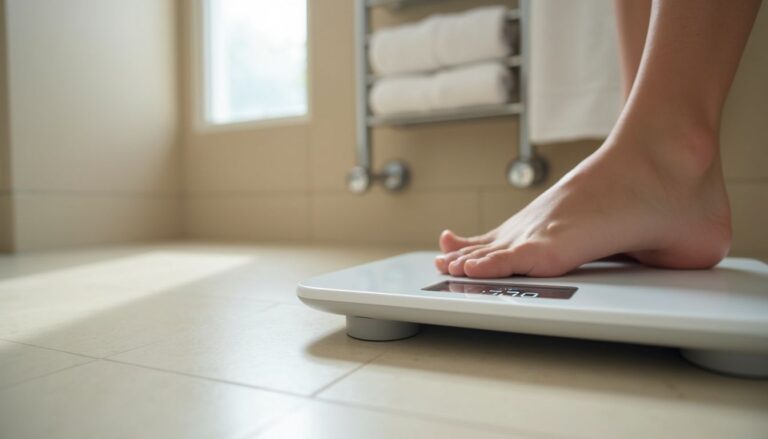Protein And Weight Loss: High-Protein Diet For Effective Weight Loss
Our Nutrition Assistant AI Suite will transform your body. You will lose fat, get toned, and build muscle. Gain confidence and optimal health.
Struggling with weight loss despite solid effort? A high-protein diet can make it easier. Eating more protein helps you feel full, protects muscle, and may raise daily calorie burn.
This guide shows how protein and weight loss connect, how to use protein for better results, and which foods deliver the most benefit with fewer extra calories. Small changes to your meals can build steady progress. Keep reading for clear steps you can use right away.
Key Takeaways
- High-protein diets often lead to more weight loss in clinical trials, including extra losses of 0.3 to 3.7 kilograms compared with standard protein plans over 1 to 6 months.
- Eating 20 to 30 percent of daily calories from protein increases satiety hormones like GLP-1, CCK, and PYY, and lowers ghrelin, the hunger hormone.
- Higher protein intake raises resting energy expenditure by about 142 calories per day in meta-analyses, and helps preserve muscle during fat loss.
- Common targets for weight loss are 1.0 to 1.8 grams of protein per kilogram of body weight per day. Athletes, older adults, and people in active fat loss may need the higher end.
- Top sources include lean meats, eggs, seafood, Greek yogurt, tofu, and lentils. If you have kidney disease or chronic illness, talk with your clinician first.
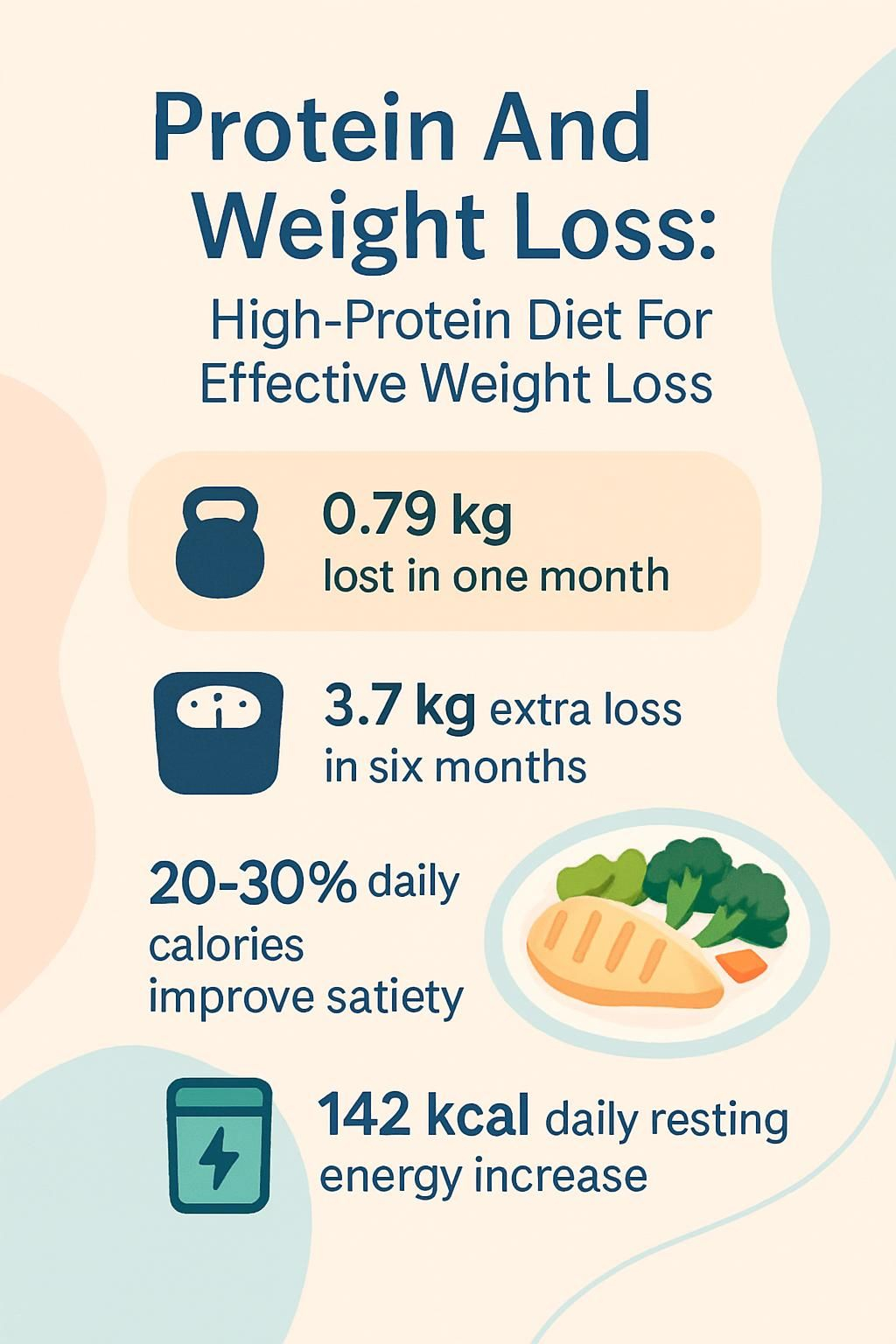
How Protein Supports Weight Loss
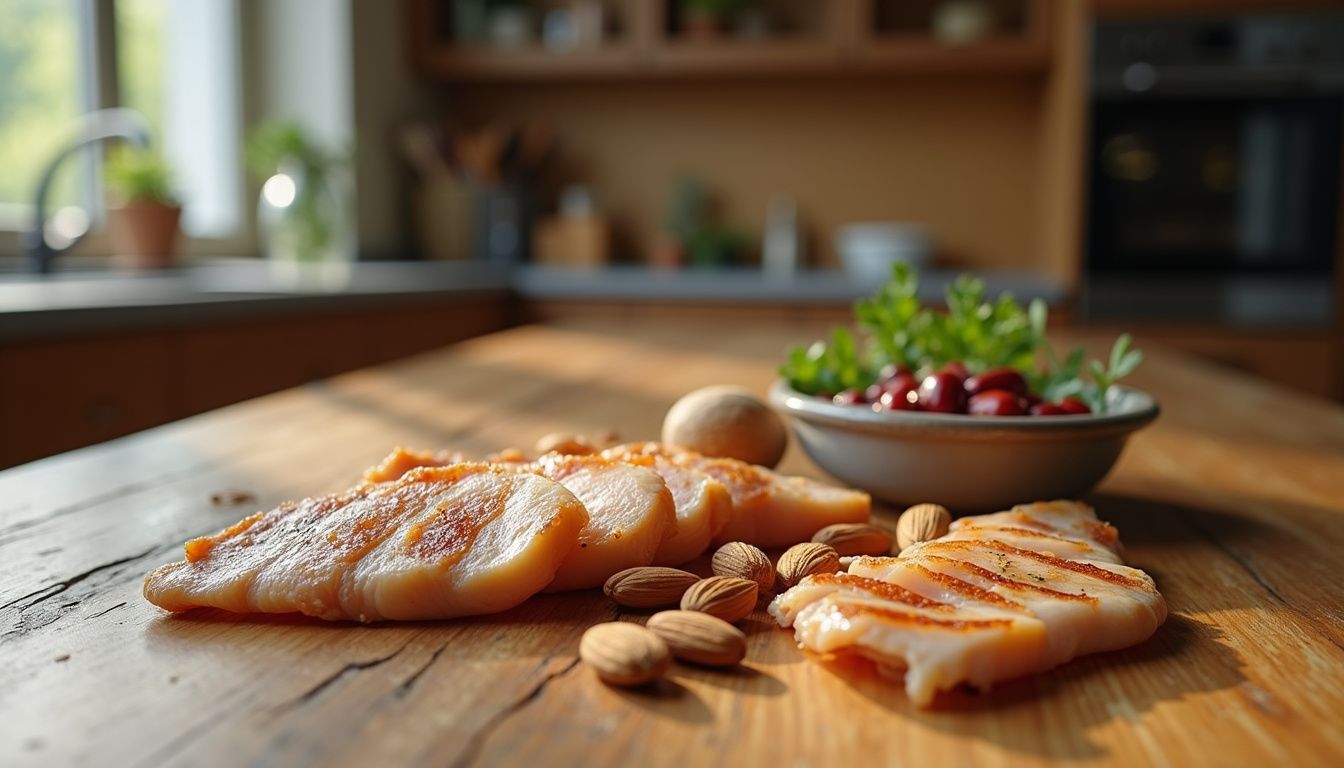
Protein works on hunger, metabolism, and muscle at the same time. This three-way effect helps you lose fat while keeping strength.
How Does Protein Reduce Hunger and Increase Fullness?
Protein boosts satiety, which means you stay full longer. It raises gut hormones such as GLP-1, cholecystokinin, and peptide YY, and it lowers ghrelin, your hunger signal. That mix reduces cravings and cuts snacking.
People who get about 25 to 30 percent of calories from protein often eat fewer calories without strict tracking. Choosing foods like chicken breast, eggs, fish, or Greek yogurt can make that happen at each meal.
What Are the Metabolic Benefits of Eating Protein?
Protein has a higher thermic effect of food, also called diet-induced thermogenesis. Your body uses 20 to 30 percent of the calories in protein to digest and process it. Carbs use about 5 to 10 percent, and fats use about 0 to 3 percent. That raises total daily calorie burn.
Meta-analyses show higher protein diets increase resting energy expenditure by about 142 calories per day. Several trials report similar gains, which supports fat loss during a calorie deficit.
Why Is Protein Important for Preserving Muscle During Weight Loss?
Muscle is metabolically active tissue. When you diet, protein helps protect it. Studies show high-protein diets preserve more fat-free mass than lower protein plans, even as scale weight drops. Keeping muscle also helps maintain your resting metabolism, which supports long-term success.
Quick example: Many people feel steadier energy and fewer cravings after raising protein at breakfast, such as eggs with Greek yogurt or cottage cheese.
Scientific Evidence for High-Protein Diets
Randomized controlled trials and meta-analyses report consistent short-term benefits. Longer trials show mixed results, often due to adherence and food choices.
What Do Key Studies Say About Protein and Weight Loss?
Short studies report modest but meaningful losses. Wycherley et al. (2012) observed about 0.79 kg lost over one month with higher protein across more than 1,000 adults. Santesso et al. (2012) found about 0.36 kg in a similar window among 1,577 adults.
Longer trials show larger gaps. Skov et al. (1999) reported about 3.7 kg more loss over six months with a high-protein diet versus a standard one. Other trials, including Weigle and Westerterp-Plantenga, found added losses in the 3 to 5 kg range across 3 to 4 months, though some year-long studies saw smaller differences due to adherence.
Switching from low-protein breakfasts to eggs and yogurt helped me stay full until lunch, which made daily calorie goals much easier to meet.
Bottom line: High-protein diets tend to improve short-term weight loss, and they can help longer term if you stick with the plan.
How Does Protein Affect Appetite and Calorie Intake?
Protein raises satiety hormones and lowers hunger signals, which helps you eat less without strict rules. Protein-rich foods also score high on the Satiety Index, so you feel satisfied longer after meals that include eggs, fish, lean meat, or legumes.
Many people notice fewer cravings and less snacking when they add protein to every meal. This often leads to a spontaneous drop in calories.
| Effect | What it means for you |
|---|---|
| Increases satiety | Boosts GLP-1, CCK, PYY, and lowers ghrelin, so you feel full longer |
| Higher Satiety Index | Protein-rich foods keep you satisfied more than sugary or fatty picks |
| Lowers calorie intake | Fewer cravings and snacks, less need for strict calorie counting |
Benefits of Following a High-Protein Diet
A high-protein approach can speed fat loss, steady blood sugar, and make weight maintenance easier. It also helps protect muscle while you lose body fat.
How Can Protein Help Speed Up Fat Loss?
Clinical studies show high-protein diets reduce fat mass more than standard diets. Meta-analyses report about 0.87 kg more fat loss with higher protein. In one six-month trial, people on a high-protein plan lost 3.3 kg more fat than a high-carb group.
Waist size often drops as well, a sign of less abdominal fat. After six months, several trials report meaningful reductions in waist circumference along with total fat loss.
What Are the Effects of Protein on Blood Sugar?
Protein helps blunt spikes in blood sugar after meals, especially when it replaces refined carbs. It slows digestion and supports steadier energy between meals.
Choosing eggs, chicken breast, Greek yogurt, beans, or nuts in place of low-fiber carbs can reduce crashes and cravings. This supports weight management and can be helpful for people at risk of metabolic syndrome. If you have diabetes, check with your care team for personalized advice.
How Does Protein Support Long-Term Weight Management?
Protein helps you keep pounds off through fullness and higher calorie burn during digestion. Trials suggest less weight regain after weight loss when daily protein is higher, especially when you spread intake across the day.
Many people find a protein-forward breakfast reduces late-morning hunger. That smoother start makes long-term habits easier to maintain.
How Much Protein Should You Eat to Lose Weight?
Your daily target depends on body size, goals, and activity. Getting this range right improves results and protects muscle.
What Are the Guidelines for Daily Protein Intake?
The general RDA is 0.8 grams per kilogram of body weight per day. For weight loss, many experts suggest 1.0 to 1.2 grams per kilogram as a baseline. During active fat loss or heavy training, 1.4 to 1.8 grams per kilogram can help preserve muscle.
Example: If you weigh 175 pounds or about 79 kilograms, start around 79 to 95 grams per day. You may go up to roughly 110 to 142 grams during tougher phases. If you have kidney disease, or take medicines that affect kidney function, talk with a registered dietitian or clinician first.
What Factors Influence Your Protein Needs?
Age, body weight, training load, and health status all matter. Athletes need more protein for recovery. Older adults often benefit from higher intakes to help prevent muscle loss. Pregnancy increases needs as well.
Conditions like chronic kidney disease, liver disease, or uncontrolled hypertension require medical guidance before you raise protein. If you start strength training, a modest bump in daily protein can improve soreness, recovery, and consistency.
Best Protein Sources for Weight Loss
Picking the right protein sources helps control hunger, support muscle, and manage calories. Combine these options to fit your taste and budget.
What Are the Best Lean Animal Protein Options?
- Skinless chicken breast, about 31 grams of protein per 100 grams, very low in saturated fat.
- Turkey breast, about 29 grams per 100 grams, light in calories and helpful for daily targets.
- Lean pork tenderloin, about 21 to 22 grams per 100 grams, with minimal visible fat.
- White fish and shrimp, about 20 to 24 grams per serving, low in calories and fat.
- Eggs, about 6 grams each, with useful vitamins and minerals.
- Lean beef cuts like sirloin or round, about 23 to 26 grams per serving, less saturated fat than fattier cuts.
- Cottage cheese, about 11 to 13 grams per half cup, an easy snack or side.
- Greek yogurt, about 17 to 20 grams per cup, choose nonfat or low-fat to limit extra calories.
These foods support muscle and satiety while keeping saturated fat in check.
Which Plant-Based Proteins Are Ideal for Weight Loss?
- Tofu, about 8 grams per 100 grams, low in fat and easy to season.
- Tempeh, about 19 grams per 100 grams, fermented soy with useful probiotics.
- Lentils, about 9 grams per half cup cooked, high in fiber for long-lasting fullness.
- Chickpeas, about 7 grams per half cup cooked, great in salads or hummus.
- Quinoa, about 4 grams per half cup cooked, contains all essential amino acids.
- Edamame, about 11 grams per half cup, protein plus fiber for snacks or sides.
- Peas, about 8 grams per cup cooked, simple add-in for bowls and soups.
- Pistachios, about 6 grams per ounce, bring protein and healthy fats for satiety.
- Spinach, small protein boost plus iron and vitamin K for overall health.
Plant proteins add fiber, which supports stable blood sugar and appetite control. Mix them with colorful vegetables for more volume and nutrients.
What Dairy and Protein Supplements Should You Choose?
- Choose Greek yogurt, cottage cheese, or kefir for 10 to 20 grams per serving plus calcium.
- Use protein shakes for busy days or post-workout, when a quick option helps you meet goals.
- Whey or casein powders provide complete proteins that support recovery and muscle repair.
- Plant-based powders like pea, soy, or rice are good choices if you prefer non-dairy.
- Pick powders with simple ingredient lists and low added sugar, ideally less than 3 grams per serving.
- Milk powder can boost protein in smoothies, oatmeal, or baked goods.
- Nut butters add moderate protein and healthy fats, tasty on fruit or whole-grain toast.
- Look for third-party testing on labels to confirm quality and purity.
Use supplements as a convenience tool, not as a full replacement for whole foods.
Tips for Succeeding on a High-Protein Diet
Plan your day so each meal includes protein. Combine protein with fiber and healthy fats to stay full and satisfied.
How Can You Add Protein to Every Meal?
- Start breakfast with eggs, turkey slices, or smoked salmon for early satiety.
- Use Greek yogurt or cottage cheese as a base for parfaits or snacks.
- Add tofu, a cup of black beans, or a cup of cottage cheese to lunch or dinner.
- Include lentils and quinoa for plant protein plus fiber and minerals.
- Snack on almonds or cashews for protein and healthy fats.
- Pair grilled chicken, fish, or shrimp with vegetables to manage calories.
- Use protein supplements if food alone falls short, and confirm the ingredient quality.
- Mix vegetables into casseroles, stir-fries, and salads for more volume with fewer calories.
Set a daily protein goal and keep a simple log so you know you are on track.
When Is the Best Time to Eat Protein?
Spread protein across the day. Aim for about 20 to 30 grams at each main meal. This pattern supports muscle maintenance and steadier appetite control.
Many people find it practical to include a protein-rich breakfast, a lean lunch, and a balanced dinner. Current research suggests equal distribution across meals works as well as large single servings.
Why Pair Protein with Fiber and Healthy Fats?
Protein fills you up, and fiber makes that fullness last. Add vegetables, beans, or whole grains to support regular digestion. Healthy fats like olive oil, avocado, and nuts improve flavor and nutrient absorption.
Try a chicken salad with chickpeas, spinach, and olive oil. It brings protein, fiber, and healthy fats together for steady energy and fewer cravings.
Risks to Consider with High-Protein Diets
High protein intake is safe for most healthy people. If you have kidney disease or chronic illness, seek medical advice first.
Can Excess Protein Cause Kidney Problems?
Healthy kidneys adapt to higher protein without harm in clinical trials. In people with reduced kidney function, higher intake can speed decline. The Nurses’ Health Study found that in women with mild impairment, each extra 10 grams of daily protein linked to lower estimated filtration over time.
If you have kidney disease, diabetes with kidney involvement, or a history of stones, ask your clinician before changing your diet. That step helps you match protein targets to your lab results and treatment plan.
Why Is Balancing Macronutrients Important?
Protein is just one piece. Carbs and fats supply energy, fiber, and essential fatty acids. The National Academy of Medicine suggests 45 to 65 percent of calories from carbs and 25 to 35 percent from fat, leaving room for a higher protein share when needed.
A balanced plate keeps energy steady and supports adherence, which is the real driver of long-term results.
High-Protein Meal Ideas for Weight Loss
Simple meal ideas make it easier to hit your targets and keep muscle while you lose fat.
What Are Some High-Protein Breakfast Options Like Eggs and Spinach?
- Scramble two eggs with a cup of spinach. You get about 14 grams of protein plus iron and fiber.
- Greek yogurt with berries and chopped nuts. One cup offers 17 to 20 grams of protein.
- Cottage cheese with sliced fruit. Half a cup provides about 12 grams.
- Egg white omelet with spinach, tomatoes, and a sprinkle of low-fat cheese.
- Whole-grain toast with one egg, turkey slices, and baby spinach, usually over 20 grams.
- Smoothie with whey or pea protein, spinach, milk or soy milk, and frozen berries.
Protein at breakfast can curb mid-morning hunger and help you stick to your plan.
How to Make Protein-Rich Lunches Such as Chicken Salad?
- Grill skinless chicken breast. A 3-ounce serving has about 26 grams of protein.
- Add chickpeas or lentils for extra protein and fiber. One cup cooked chickpeas has about 15 grams.
- Mix in quinoa for texture and 8 grams of protein per cup cooked.
- Use nuts like almonds or walnuts for crunch and healthy fats.
- Swap mayonnaise for Greek yogurt to raise protein and cut calories.
- Load up on spinach, tomatoes, cucumbers, and bell peppers for volume and vitamins.
- Prep lunch the night before to avoid last-minute lower-quality choices.
- Eat slowly so you can notice fullness and stop at comfortable satiety.
- Season with herbs, citrus, and spices for flavor without extra sugar or sodium.
This approach combines lean protein, fiber, and healthy fats for a satisfying mid-day meal.
What Are Nutrient-Dense Dinner Ideas Like Salmon and Quinoa?
- Grilled salmon with steamed quinoa, often 35 grams of protein or more, plus omega-3 fats.
- Quinoa bowl with roasted chickpeas, spinach, tomatoes, and lemon for plant protein and fiber.
- Baked tempeh over quinoa with black beans and peppers for about 30 grams of plant protein.
- Stir-fry with chicken breast, broccoli, edamame, and quinoa for steady blood sugar.
- Seared tuna with warm quinoa salad, olive oil, and herbs for complete protein and antioxidants.
- Stuffed peppers with quinoa, white beans, and mushrooms, high in iron and B vitamins.
- Grilled shrimp over herbed quinoa pilaf, quick to cook and rich in minerals.
Round out the plate with a large serving of non-starchy vegetables for fullness and fiber.
What Healthy Protein Snacks Can You Eat, Like Greek Yogurt and Almonds?
- Greek yogurt, about 10 to 15 grams per serving. Add fruit for sweetness.
- Almonds, about 6 grams per ounce, easy to carry and shelf stable.
- Cashews or peanuts, about 5 to 7 grams per ounce.
- Nut butters, 4 to 7 grams per two tablespoons, great with apples or toast.
- Hard-boiled eggs, about 6 grams each, ready in minutes.
- Edamame, about 8 grams per half cup, steam or buy shelled.
- Low-fat string cheese, about 6 to 8 grams per stick.
- Turkey or chicken slices rolled with vegetables for a fast bite.
- Cottage cheese, up to 13 grams per half cup, plain or with berries.
Keeping two portable protein snacks on hand helps you avoid impulse choices and stay on track.
Protein Shakes and Weight Loss
Protein shakes are a practical tool. They fill gaps on busy days and can support muscle while you lose fat.
What Are the Benefits of Using Protein Shakes?
Shakes offer fast, measurable protein with little prep. They can reduce hunger, support muscle, and help you meet daily protein goals, especially if you train.
Many people find one shake in the morning or after a workout cuts cravings later in the day.
How Do You Choose Healthy Protein Powders?
Pick powders with few ingredients and low added sugar. Aim for at least 20 grams of protein and less than 3 grams of sugar per serving. Whey and soy are complete proteins. Pea and blends also work well.
Test a small size for taste and texture. Avoid fillers and artificial sweeteners if they upset your stomach. Read labels closely so each scoop supports your plan instead of adding extra calories.
Combining Exercise with High-Protein Nutrition
Protein plus strength training is a strong pair. The right mix helps you keep muscle while you lower body fat.
How Does Protein Help Muscle Recovery and Growth?
After lifting or resistance work, muscle fibers need amino acids to repair and grow. Protein stimulates muscle protein synthesis, the rebuilding process your body uses after training.
During weight loss, higher protein helps preserve fat-free mass. That means better recovery, more strength over time, and a healthier metabolism.
How to Combine Strength Training with Protein Intake?
- Eat 20 to 30 grams of high-quality protein within 60 minutes after lifting.
- Spread your protein over three to four meals to keep rebuilding signals active.
- Use lean sources such as chicken, eggs, fish, Greek yogurt, tofu, or lentils.
- If training is intense, consider 0.7 to 1.0 grams per pound of body weight during cutting phases.
- Mix strength work with cardio while meeting your daily protein target.
- Track intake with a simple app or journal to stay consistent.
Small, steady habits beat big swings. Consistency brings the best results.
Common Myths About High-Protein Diets
Some myths persist about protein and health. Evidence gives a clearer picture.
Is Eating Protein Harmful to Kidney Health?
Trials in healthy adults show no harm to kidney function at typical high-protein levels used in studies, often 25 to 30 percent of calories. Blood markers like creatinine and estimated filtration remain stable. People with existing kidney disease should not increase protein without medical care.
Does Protein Affect Bone Health Negatively?
Higher protein intake is linked with less bone loss in older adults in several studies. Low protein can increase fracture risk because bones and muscles both rely on adequate amino acids.
Pair protein with calcium and vitamin D. That combination supports bone strength across adulthood.
Best Practices for a High-Protein Diet
Track your intake, keep meals balanced, and drink enough fluids. These basics make a high-protein approach more effective.
How Should You Monitor Protein Intake?
Set a daily target such as 1.0 to 1.2 grams per kilogram, then measure what you eat. Use a food scale for a week to learn portions. After that, a tracking app or simple checklist keeps you consistent.
Adjust your target based on progress, hunger, training load, and feedback from your clinician or dietitian.
Why Is Hydration Important When Eating More Protein?
Processing more protein raises fluid needs. Water helps your kidneys clear urea, a waste product from protein metabolism. Low fluid intake can lead to constipation, headaches, or fatigue.
As a general guide, aim for about 3.7 liters per day for men and 2.7 liters for women from all foods and drinks, especially during higher protein phases. Sip across the day instead of chugging at night.
Common Mistakes in High-Protein Dieting
People often focus on protein and forget balance, fiber, or total calories. Avoid these traps for better results.
How to Maintain Nutritional Balance While Eating Protein?
- Mix animal and plant proteins for a wider nutrient range and taste variety.
- Add complex carbs like quinoa, brown rice, oats, or sweet potatoes for steady energy.
- Include healthy fats such as olive oil, avocado, seeds, and nuts for fullness and vitamin absorption.
- Cover half your plate with vegetables at lunch and dinner for fiber and micronutrients.
- Choose mostly whole foods instead of frequent bars and ready-to-drink shakes.
- Drink enough water to match higher protein intake.
- Watch portions, even for lean protein, since calories still count.
- Rotate proteins weekly to prevent boredom and broaden your nutrient base.
- Use a simple food log to spot gaps in fiber, fruits, or vegetables.
- Plan meals in advance so you do not rely on last-minute takeout.
Why Avoid Overusing Processed Protein Sources?
- They often contain excess sodium that can raise blood pressure.
- Additives and preservatives may cause digestive issues in sensitive people.
- Extra fats in some processed meats can slow fat loss.
- Bars and shakes can contain artificial flavors or colors.
- Most lack fiber compared with whole-food proteins like beans or chicken.
- Whole foods provide vitamins, minerals, and antioxidants that support health.
- Diets high in ultra-processed foods may raise heart disease risk in research.
- Many people feel fuller longer after meals built from eggs, fish, tofu, or beans.
- Choosing simple whole foods makes calorie control more predictable.
Use processed items as backup, not as your main protein source.
Who Should Be Careful with High-Protein Diets?
Some groups need tailored advice. If you have a medical condition, get clearance before you change your diet.
Who Might Not Be Suitable for High-Protein Diets?
People with kidney disease or reduced kidney function should limit protein based on medical guidance. Those with advanced liver disease or uncontrolled hypertension also need personalized targets.
If you manage diabetes or take medications that affect the kidneys, ask your clinician for a safe range and monitoring plan before raising protein intake.
When Should You Consult a Health Professional?
Consult a health professional if you are pregnant or nursing, an athlete with high training volume, over age 65, or living with chronic illness. Sudden fatigue, poor appetite, or digestive issues after raising protein are also signs to check in.
A registered dietitian can help you set a protein goal, pick foods you enjoy, and build a plan that fits your medical needs.
Conclusion
A high-protein diet can make weight loss simpler and more sustainable. Protein increases fullness, supports muscle, and slightly raises daily calorie burn. Aim for 20 to 30 percent of calories from protein, or about 1.0 to 1.8 grams per kilogram of body weight during active loss.
Fill your plate with lean meats, eggs, seafood, yogurt, tofu, beans, and lentils. If you have kidney disease or other medical concerns, talk with your clinician before changing your diet. Small, consistent steps with smart protein choices help you protect muscle while you reach and maintain a healthy weight.
Health information here is educational and not a substitute for personal medical advice. Consult your healthcare professional for guidance that fits your situation.
FAQs
1. How does a high-protein diet support weight loss?
A high-protein eating plan helps reduce hunger and increases feelings of fullness, which can lead to lower calorie intake. Research shows that protein-rich foods boost metabolism by increasing the number of calories burned during digestion. Studies published in The American Journal of Clinical Nutrition found that people who increased their protein intake lost more body fat than those on standard diets.
2. What are good sources of protein for effective weight management?
Lean meats such as chicken breast, turkey, and fish provide quality protein with fewer calories from fat. Dairy products like Greek yogurt and cottage cheese also offer significant amounts of protein per serving. Plant-based options include lentils, beans, tofu, and quinoa; these choices supply fiber along with essential amino acids.
3. Is there an ideal amount of daily protein for losing weight?
Experts recommend consuming between 0.6 to 0.8 grams of dietary protein per pound of body weight each day when aiming for healthy weight reduction (Phillips et al., 2016). For example, a person weighing 150 pounds should aim for about 90 to 120 grams daily from various food sources.
4. Can you share a personal experience using a high-protein approach for fat loss?
After switching my breakfast from cereal to eggs and low-fat cottage cheese, I noticed less mid-morning hunger and felt satisfied longer throughout the day. This simple change made it easier to avoid snacks before lunch while supporting steady progress toward my fitness goals.
Summary: High-protein diets help control appetite and increase calorie burn through digestion; lean meats, dairy items, legumes, tofu, and grains serve as strong choices; experts suggest specific intake targets based on body size; real-life changes show practical benefits in managing hunger during weight loss efforts.


